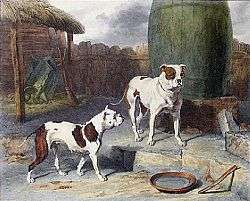Abraham Cooper


Abraham Cooper RA (1787–1868), was an English animal and battle painter.
Life
The son of a tobacconist, he was born in Greenwich, London.[1] At the age of thirteen he became an employee at Astley's Amphitheatre, and was afterwards a groom in the service of Henry Meux, a brewer and later the first of the Meux baronets. When he was twenty-two, wishing to possess a portrait of a favorite horse under his care, he bought a manual of painting, learned something of the use of oil-colours, and painted the picture on a canvas hung against the stable wall. His master bought it and encouraged him to continue in his efforts. He accordingly began to copy prints of horses, and was introduced to Benjamin Marshall, the animal painter, who took him into his studio, and seems to have introduced him to the Sporting Magazine, an illustrated periodical to which he was himself a contributor.[2]
In 1814 he exhibited his Tam O'Shanter, and in 1816 he won a prize for his Battle of Ligny. In 1817 he exhibited his Battle of Marston Moor and was made associate of the Royal Academy, and in 1820 he was elected Academician. Cooper, although ill-educated, was a clever and conscientious artist; his colouring was somewhat flat and dead, but he was a master of equine portraiture and anatomy, and had some antiquarian knowledge. He had a special fondness for Cavalier and Roundhead pictures.[2]
Paintings
- Bosworth Field (1825, Dallas Museum of Fine Arts)
- The Death of Sir Francis Russell, who was treacherously slain at a Border Meeting, July 16, 1585 (1827, Duke of Bedford, Woburn Abbey)
- Battle of Zutphen, 1586 (1826 - Duke of Bedford, Woburn Abbey)
- The Battle of Marston Moor (1819 - Harris Museum and Art Gallery, Preston)
- The Heroic Conduct of Cromwell at Marston Moor (1821 - Chequers House, Buckinghamshire)
- Cromwell leading his Cavalry into Battle (Cambridgeshire Museums, at Cromwell House, Huntingdon)
- Battle Scene (attr.) (Guildhall Art Gallery)
- Wellington's First Great Victory - The Battle of Assaye (The Light Dragoons)
- The Battle of Ligny (Lord Egremont, Petworth House)
Gallery
-

Crib and Rosa, 1817
-

Tam O'Shanter
-
_Cooper.jpg)
Richard III and the Earl of Richmond During the Battle of Bosworth Field
-
%2C_after_Abraham_Cooper%2C_RA%2C_(1787%E2%80%931868)%2C_shooting_scene%2C_UK.jpg)
Engraving after Cooper, by Edward Hacker (1813–1905), 1866.
References
- ↑ "Fighting for the Standard at the Battle of Marston Moor", Metropolitan Museum of Art collections. Retrieved 10 June 2015
- 1 2
 One or more of the preceding sentences incorporates text from a publication now in the public domain: Chisholm, Hugh, ed. (1911). "Cooper, Abraham". Encyclopædia Britannica. 7 (11th ed.). Cambridge University Press. p. 78.
One or more of the preceding sentences incorporates text from a publication now in the public domain: Chisholm, Hugh, ed. (1911). "Cooper, Abraham". Encyclopædia Britannica. 7 (11th ed.). Cambridge University Press. p. 78.
Works about
| Wikimedia Commons has media related to Abraham Cooper. |
- Harrington, Peter (1993). British Artists and War: The Face of Battle in Paintings and Prints, 1700–1914. London: Greenhill. ISBN 1853671576